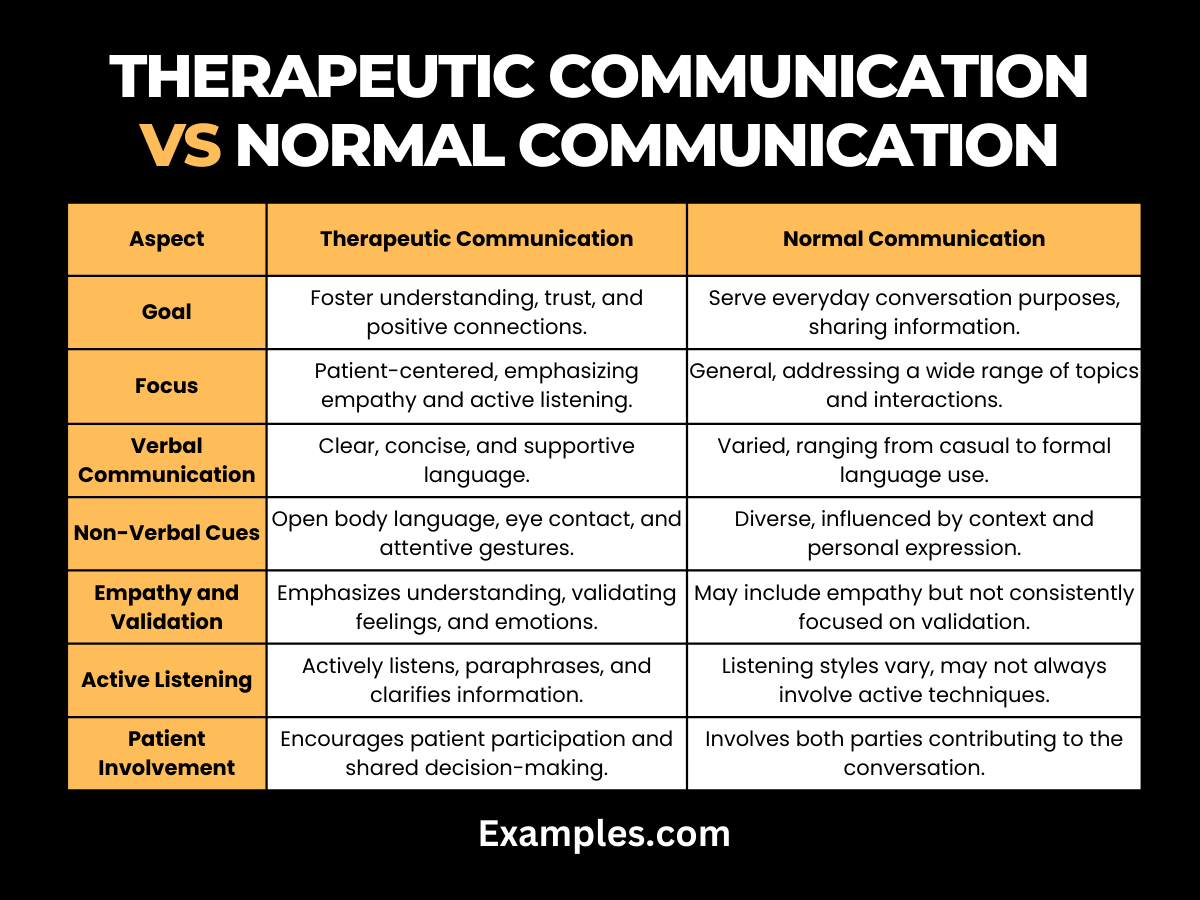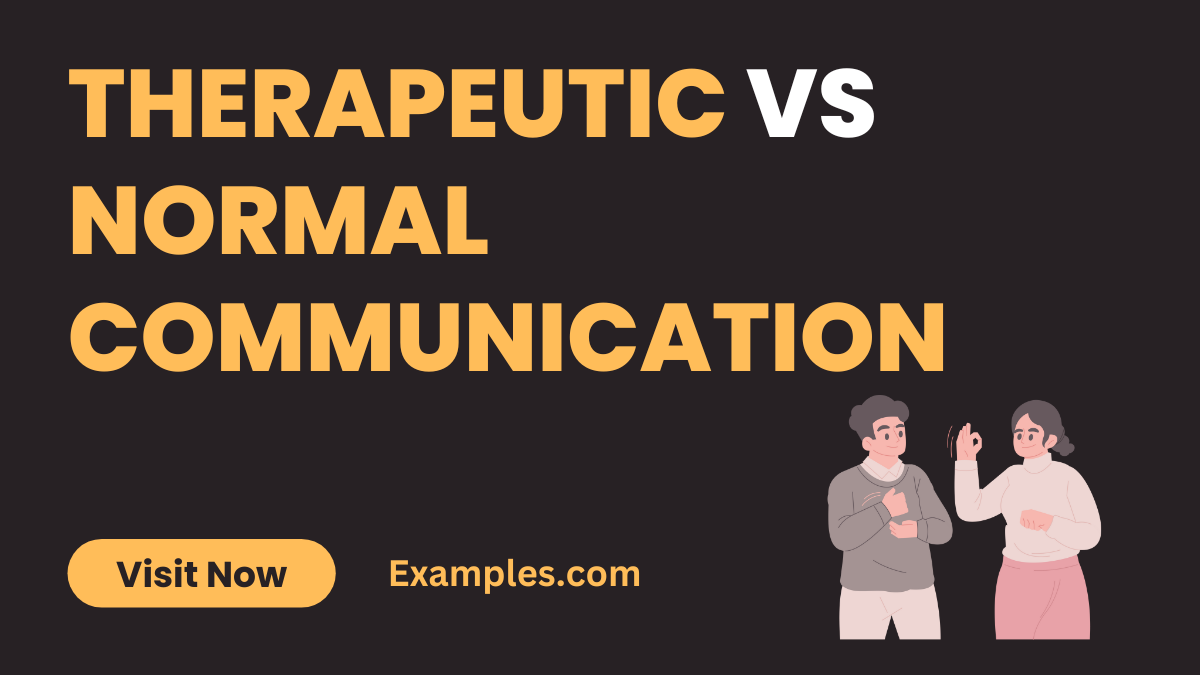Therapeutic Communication vs Normal Communication – 9+ Examples
Unlock the nuances of Therapeutic Communication vs Normal Communication in this detailed guide. Explore examples that go beyond conventional interactions, offering a deeper understanding of these communication styles. Dive into practical insights, usage tips, and effective strategies to elevate your interpersonal skills. Whether in healthcare or everyday conversations, this guide provides a wealth of communication examples, empowering you to foster meaningful connections and navigate diverse social interactions with confidence.
What is the difference between Therapeutic Communication and Normal Communication?

In navigating interpersonal interactions, understanding the disparities between therapeutic and normal communication is pivotal. The following table outlines key differences to enhance your communication skills:
| Aspect | Therapeutic Communication | Normal Communication |
|---|---|---|
| Goal | Promote understanding, trust, and positive connections. | Serve everyday conversation purposes, sharing information. |
| Focus | Patient-centered, emphasizing empathy and active listening. | General, addressing a wide range of topics and interactions. |
| Verbal Communication | Clear, concise, and supportive language. | Varied, ranging from casual to formal language use. |
| Non-Verbal Cues | Open body language, eye contact, and attentive gestures. | Diverse, influenced by context and personal expression. |
| Empathy and Validation | Emphasizes understanding, validating feelings, and emotions. | May include empathy but not consistently focused on validation. |
| Active Listening | Actively listens, paraphrases, and clarifies information. | Listening styles vary, may not always involve active techniques. |
| Patient Involvement | Encourages patient participation and shared decision-making. | Involves both parties contributing to the conversation. |
| Relationship Building | Strengthens therapeutic alliances for positive outcomes. | Establishes connections for general social or work purposes. |
| Use of Silence | Utilizes purposeful silence for reflection or understanding. | Silence is context-dependent, not always intentional. |
| Feedback and Reflection | Provides constructive feedback, fostering growth. | Feedback styles may vary, ranging from constructive to casual. |
| Cultural Sensitivity | Demonstrates cultural competence and sensitivity. | Cultural sensitivity may vary based on individuals involved. |
Understanding these distinctions empowers individuals to adapt their communication style based on the context and desired outcomes, fostering effective interactions in diverse situations.
10 Therapeutic Communication Examples
Discover therapeutic communication examples that transcend words, fostering profound connections. Each example is thoughtfully crafted to enhance your communication skills across various contexts. Elevate your ability to empathize, understand, and engage effectively.
- Active Listening:
Example: engage with, “I hear your concerns; let’s discuss how we can address them.” - Empathetic Responses:
Example: Demonstrate understanding with, “I can see this situation is challenging for you; I’m here to support.” - Open-Ended Questions:
- Example: Encourage comprehensive responses, “Can you share more about how you’ve been feeling lately?”
- Reflective Techniques:
Example: Use reflection with, “It seems like you’re feeling overwhelmed; tell me more about it.” - Cultural Sensitivity:
Example: Acknowledge diversity, “I appreciate your perspective; let’s ensure our approach aligns with your cultural preferences.” - Silence as Support:
Example: Provide reflection time, “Take your time; I’m here whenever you’re ready to talk.” - Validation of Feelings:
Example: Acknowledge emotions, “Your feelings are valid; let’s work through this together.” - Positive Reinforcement:
Example: Recognize positive behaviors, “I noticed your efforts; your dedication is making a difference.” - Clarification:
Example: Ensure mutual understanding, “Let me confirm I understand correctly; you’re saying…” - Problem-Solving Collaboration:
Example: Collaborate on solutions with, “Let’s brainstorm together to find a solution that works for both of us.”
These therapeutic communication examples empower you to establish connections, provide support, and contribute to positive outcomes in diverse interpersonal interactions.
10 Normal Communication Examples
Explore everyday scenarios with these normal communication examples, showcasing the simplicity of daily interactions. Enhance your ability to convey thoughts and connect with others effortlessly across various situations.
- Casual Greetings:
Example: Engage with a simple “Hello, how are you?” for friendly encounters. - Sharing Information:
Example: Communicate facts directly, such as “The meeting is at 3 PM in the conference room.” - Expressing Opinions:
Example: Share your viewpoint straightforwardly, saying “I think we should consider this option.” - Giving Directions:
Example: Offer clear instructions like “Turn left at the intersection, and you’ll find the office.” - Thanking Someone:
Example: Express gratitude with a straightforward “Thank you for your help.” - Apologizing:
Example: Acknowledge mistakes with “I’m sorry for any inconvenience caused.” - Requesting Information:
Example: Seek details politely, asking “Could you please provide more information on this topic?” - Setting Plans:
Example: Make plans with “Let’s meet for lunch at the new café downtown.” - Small Talk:
Example: Engage in casual conversation with “How was your weekend?” - Sharing Personal News:
Example: Inform others about personal news, saying “I got a promotion at work!”
These normal communication examples demonstrate the simplicity and effectiveness of everyday interactions, showcasing the diverse ways we connect with others.
What is the Comparison between Therapeutic Communication and Normal Communication?
Understanding the distinctions between therapeutic communication and normal communication is crucial for effective interpersonal interactions. This comprehensive table compares key aspects of both styles:
| Aspect | Therapeutic Communication | Normal Communication |
|---|---|---|
| Goal | Foster understanding, trust, and positive connections. | Achieve mutual understanding and convey information. |
| Focus | Patient-centered, emphasizing empathy and active listening. | Situation-centered, conveying information or exchanging ideas. |
| Verbal Communication | Clear, concise, and supportive language. | Varied, depending on the context, from casual to formal speech. |
| Non-Verbal Cues | Open body language, eye contact, and attentive gestures. | May vary widely, encompassing gestures, expressions, and body language. |
| Empathy and Validation | Emphasizes understanding, validating feelings, and emotions. | May or may not include explicit expressions of empathy and validation. |
| Active Listening | Actively listens, paraphrases, and clarifies information. | Listens to understand, may not always involve active techniques. |
| Patient Involvement | Encourages patient participation and shared decision-making. | May involve one-way communication or shared decision-making based on context. |
| Relationship Building | Strengthens therapeutic alliances for positive outcomes. | Focuses on building connections, but not always with therapeutic objectives. |
| Use of Silence | Utilizes purposeful silence for reflection or understanding. | Silence may occur naturally or be used for various reasons in communication. |
| Feedback and Reflection | Provides constructive feedback, fostering growth. | Feedback may vary in formality and purpose, not always focused on personal growth. |
| Cultural Sensitivity | Demonstrates cultural competence and sensitivity. | May or may not prioritize cultural sensitivity in communication. |
This comparative guide highlights the nuanced differences between therapeutic communication, which is often patient-centered and empathetic, and normal communication, which spans a broader range of everyday interactions. Understanding these distinctions enhances our ability to engage effectively in diverse social situations.
What is the Relationship Between Therapeutic Communication and Normal Communication?
In the realm of interpersonal interactions, understanding the distinctions between therapeutic and normal communication is crucial. This table highlights key aspects of their relationship:
| Aspect | Therapeutic Communication | Normal Communication |
|---|---|---|
| Goal | Foster understanding, trust, and positive connections. | Serve general communication needs without a specific goal. |
| Focus | Patient-centered, emphasizing empathy and active listening. | Primarily task-oriented or centered around daily interactions. |
| Verbal Communication | Clear, concise, and supportive language. | Varied, ranging from casual to formal, depending on the context. |
| Non-Verbal Cues | Open body language, eye contact, and attentive gestures. | Diverse non-verbal cues reflecting the nature of the conversation. |
| Empathy and Validation | Emphasizes understanding, validating feelings, and emotions. | General acknowledgment without always delving into deep emotional aspects. |
| Active Listening | Actively listens, paraphrases, and clarifies information. | Listening may be more passive and focused on information gathering. |
| Patient Involvement | Encourages patient participation and shared decision-making. | May or may not involve active participation based on the context. |
| Relationship Building | Strengthens therapeutic alliances for positive outcomes. | Contributes to relationship-building but may not have specific therapeutic goals. |
| Use of Silence | Utilizes purposeful silence for reflection or understanding. | Silence is used more casually and may not have a specific therapeutic intent. |
| Feedback and Reflection | Provides constructive feedback, fostering growth. | Feedback is given based on the nature of the interaction but may not always promote growth. |
| Cultural Sensitivity | Demonstrates cultural competence and sensitivity. | Cultural sensitivity is considered but may not be as explicit or emphasized. |
Understanding the relationship between therapeutic and normal communication is essential for navigating various social interactions and ensuring that communication aligns with specific goals and contexts.
In conclusion, understanding the key differences between therapeutic and normal communication is vital for effective interpersonal interactions. Therapeutic communication, often patient-centered and empathetic, focuses on building trust, understanding, and positive connections. It involves active listening, empathy, validation, and cultural sensitivity, making it crucial in healthcare settings and beyond. Normal communication, on the other hand, serves general communication needs, is more task-oriented, and varies widely in verbal and non-verbal cues. These differences highlight the importance of adapting communication styles to suit specific contexts and objectives, thereby enhancing our ability to connect and engage with others in a meaningful way.



